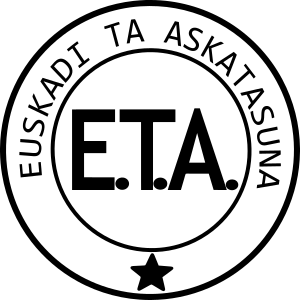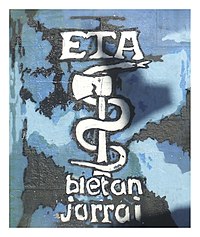ETA (separatist group) facts for kids
Quick facts for kids Euskadi Ta Askatasuna |
|
|---|---|
| Participant in Basque conflict | |

Euskadi Ta Askatasuna's symbol
|
|
| Active | 31 July 1959 – 16 April 2018
|
| Ideology |
|
| Leaders |
|
| Headquarters | Greater Basque Country |
| Area of operations |
|
| Allies |
|
| Opponents |
|
ETA, an acronym for Euskadi Ta Askatasuna ("Basque Homeland and Liberty" or "Basque Country and Freedom"), was a nationalist separatist militant army. It wanted to establish a separate nation-state for the Basque people. The Basque people are an ethnic group living in areas of northern Spain and southwestern France. There are between 2 and 2.5 million Basques in the region. Some of them speak an indigenous, non-Indo-European language called Euskara.
Contents
Description
ETA was one of Europe’s most notorious and long-running terror groups. It was founded in 1959 from what was left of EKIN, another radical Basque separatist group. Both EKIN and ETA were created because of discontent with the moderate nationalism of the main Basque party, the Basque National Party. ETA committed hundreds of attacks in Spain. It had ties with other terrorist groups both inside and outside the Basque region. These included the Provisional Irish Republican Army (IRA) and Colombia’s FARC.
Attacks
Most of ETA’s terror attacks targeted businesses and Spanish government officials, especially members of the security services and the judiciary, but it also targeted civilians. Its most common tactics were bombing and assassination. Its attacks took place mostly in the Basque Country, Madrid and Catalonia. Similar to the IRA, ETA sometimes issued warnings before the attacks.
The group assassinated Admiral Luis Carrero Blanco in December 1973. At the time, Blanco was seen by many as the most likely successor to Spain’s dictator, Francisco Franco. He was killed when an underground bomb exploded underneath his car. More than twenty years later, ETA nearly assassinated Jose Maria Aznar, an opposition politician who later became prime minister. In 1987, ETA killed 21 people in Barcelona using a car bomb.
Status change
The status of the Basque homeland changed significantly with the end of Francisco Franco's regime and the return of democracy in 1979. Franco tried to suppress Basque nationalism and separatism. The new democratic government, on the other hand, offered significant autonomy to the Basque provinces. In a deal struck in 1980, the Basque region acquired its own parliament similarly to the other regions in Spain. It was also allowed to have its own independent tax legislation. In addition, the language Euskara became more prominent in public culture and education. However, the new autonomous region did not deter the radical separatists that comprised ETA. ETA has committed approximately 900 murders and dozens of kidnappings.
Change of activity
ETA’s level of activity has changed over the years. The group has attempted several ceasefires, including a 14-month one that lasted until December 1999. While there have been a number of ETA attacks since 2000, the group has claimed fewer victims. It is believed to be shrinking. Spanish officials believe that recent crackdowns have led to a serious weakening of the group and sense that its future as a terrorist organization may be limited. There are more than one hundred suspected ETA members in Spanish prisons today.
2000s
In the past several years, ETA has done sporadic attacks, including bombings in September 2004, December 2005, and early 2006. However, these bombings were generally preceded by warnings and did not result in any deaths.
In March 2006, ETA declared a permanent ceasefire and expressed to join the political process. The decision may have been linked to the 2004 Madrid train bombings, which killed nearly 200 people. The attack was originally blamed on ETA, though it was soon discovered to be the work of militant Islamists linked to al-Qaeda. Like the IRA, ETA leaders may have felt that the mass casualty terrorism practiced by some radical Islamist groups discredited its violent tactics—though this is not known for certain. ETA had a secretive leadership structure.
In June 2007, ETA declared its March 2006 ceasefire null-and-void. Although many had seen ETA’s December 2006 bombing of an airport parking garage as an indication that the truce would not hold. An ETA spokesperson accused the Spanish government of interfering in Basque local elections as well as continuing with the prosecution and conviction of ETA members during the ceasefire.
It must be noted that ETA did not officially renounce violence or initiate steps to decommission its weapons (as the IRA did in July 2005) as part of its ceasefire declaration. ETA ceasefires have deteriorated into violence before.
2010s
On 20 October 2011, ETA announced publicly the definite cessation of its armed activities. Although it vowed to continue to seek an independent Basque state. It was announced in 2 prominent nationalist newspapers, Gara and Berria.
In May 2018 ETA announced that it was formally disbanding. The move marked the end of a half-century of violence that had claimed the lives of more than 800 people.
In the media
Films
Documentary films
- , about the families of Basque politician Fernando Buesa and his bodyguard, both killed by ETA.
- The Basque Ball: The Skin Against the Stone, (La Pelota Vasca, 2003) about the Basque conflict by filmmaker Julio Medem: interviews about Basque nationalism and politics. Includes testimonials of ETA victims and relatives of ETA prisoners.
- , Eterio Ortega and Elías Querejeta interview local councillors threatened by ETA.
- , the testimony of some of ETA's victims in the last 30 years by filmmaker Iñaki Arteta.
- 48 horas: A movie about the kidnapping of Miguel Angel Blanco and his subsequent murder
- ETA. Une histoire basque, about the history of ETA
- In 2009 a video posted on YouTube subtitled in French shows an inside view of an ETA cell with their methods of action, notably, bomb making and ID card falsification. Also, there is footage of outdoor military training and of the Basque Warrior Day (Gudari Eguna).
- Chronique Basque About a Basque politician who is the target of an ETA death threat.
- Asier ETA biok ("Asier and/ETA I", 2013) Filmmaker Aitor Merino explores his relation with his childhood friend Asier Aranguren, who had become an ETA member.
- El fin de ETA a documentary about the history of ETA
Other fact-based films about ETA
- Commando Txikia (José Luis Madrid, 1977)
- Operación Ogro (Operation Ogre, 1979), Gillo Pontecorvo's film about the assassination of Luis Carrero Blanco.
- El proceso de Burgos ("The Burgos Trial", Imanol Uribe, 1979)
- , about the Segovia prison break when ETA prisoners escaped from Segovia prison.
- Proceso a ETA at the Internet Movie Database ("The Trial of ETA", Manuel Macià, 1988)
- Yoyes, María Dolores Katarain, also known as "Yoyes", tries to leave ETA and is killed by her former comrades.
- El lobo, based on the life of Mikel Lejarza, who, prompted by the Spanish police, entered ETA to be a double agent.
- Munich, where the squad of Israeli operatives pretend to be members of ETA to avoid conflict with a squad of PLO operatives whilst sharing a neutral safe house.
- GAL at the Internet Movie Database, about the journalistic research leading to the uncovering of the state-supported GAL.
- Tiro en la Cabeza (2008) ("A bullet in the head"), about the life of an ETA member the day he will kill two Spanish Policemen in Capbreton, France.
- Una Bala Para el Rey at the Internet Movie Database ("A Bullet for the King", March 2009) about ETA's failed plot to murder Juan Carlos I during his holidays in Majorca in 1995.
- Maixabel (2021) about the meetings between Maixabel Lasa, widow of an assassinated politician, and the repenting assassins.
Fictional films featuring ETA members and actions
- El caso Almería ("The Almería Case", Pedro Costa Musté, 1983)
- La Muerte de Mikel ("The Death of Mikel", Imanol Uribe, 1983)
- it:Goma 2 (José Antonio de la Loma, 1984)
- Ander y Yul ("Ander and Yul", Ana Díez, 1988)
- Días de humo ("Days of Smoke", Antton Eceiza, 1989)
- Sombras en una batalla ("Shadows in a Battle", Mario Camus, 1993)
- Días contados ("Counted Days", Imanol Uribe, 1994)
- A ciegas ("Blinded", Daniel Calparsoro, 1997)
- The Jackal (Michael Caton-Jones, 1997)
- El viaje de Arián ("Arián's Voyage", Eduard Bosch, 2001)
- La voz de su amo ("His Master's Voice", Emilio Martínez Lázaro, 2001)
- Esos cielos ("Those skies", Aitzpea Goenaga, 2006)
- Todos estamos invitados ("We are all invited", Manuel Gutiérrez Aragón, 2008)
- Casa de mi padre ("My Father's House", Gorka Merchán, 2008)
- Celda 211 ("Cell 211", Daniel Monzón, 2009)
- Carlos (Olivier Assayas, 2010)
- Bomb Scared (Borga Cabeaga, 2017)
- Patria ("Fatherland", Aitor Gabilondo, 2020). Based on the novel Patria (Fernando Aramburu, 2016) fictional, but based on the social conflict between families of ETA members and families of the victims.
Novels
- The Spanish Game (Charles Cumming, 2006)
- The Sands of Time (Sidney Sheldon, 1988)
- The Fish of Bitterness (Los peces de la amargura) in Spanish (Fernando Aramburu, 2006)
- A Basque Story (M. Bryce Ternet, 2009)
- Fatherland (Patria) in Spanish (Fernando Aramburu, 2016)
- The Absent (Los Ausentes) in Spanish (Juana Cortés Amunarriz, 2021)
Video games
- In Counter-Strike: Global Offensive, the group is represented by the in-game faction The Separatists and as playable characters on the in-game map de_Inferno (defusal group) and cs_italy (hostage group).
Images for kids
-
Graffiti in Pasaia (2003). "ETA, the people with you" on the left, and Batasuna using several nationalist symbols asking for "Independence!"
-
Memorial plate at the place of the assassination of Admiral Luis Carrero Blanco
-
A republican mural in Belfast showing solidarity with the Basque nationalism.
See also
- Etxerat
- José Larrañaga Arenas
- Felix Likiniano
- Julen Madariaga
- Kasilda Hernáez









